Crypto Research Fundamentals & Social Signals: Your Daily Trading Strategy
In this section, we’re going to talk about how to research crypto!
Crypto is no longer a buzzword. It’s already a household name for the financial system of the future. But… Getting into crypto didn’t get easier. Matter of fact, it’s probably the opposite, since the number of crypto coins is already in the tens of thousands, and news about new scams comes from every corner.
So, quite naturally, an important question arises: How to research crypto and how not to get tangled up in the maze of new projects, complicated terminology and overwhelming feeling of FOMO? Well, in this section, I will tell you all about it.
In this section, we’re going to look into how to research crypto, what to research when buying crypto, how is this process done correctly, and what to concentrate on while doing your own research.
Without further ado, let's get to it!

Video Explainer
Video Explainer: Crypto Research Fundamentals & Social Signals: Your Daily Trading Strategy
Reading is not your thing? Watch the "Crypto Research Fundamentals & Social Signals: Your Daily Trading Strategy" video explainer
Crypto Research Fundamentals: How to DYOR (Animated Explainer)


Crypto Research 101
First of all, ironically enough, even the word ‘research’ requires some research. Here’s what I mean.
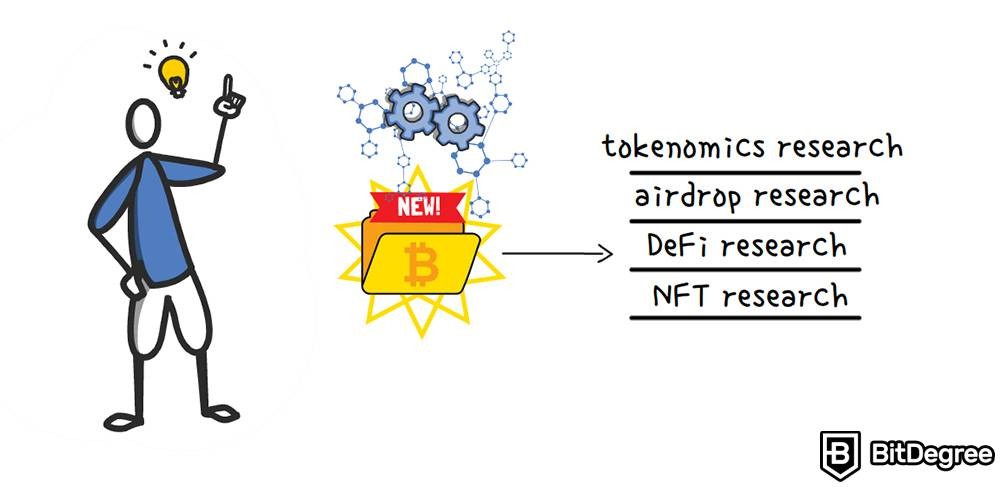
Let’s say you’re about to begin researching a new crypto project. Alright, where do you begin? These projects often have many layers to them. You can conduct tokenomics research, airdrop research, DeFi research, NFT research… There are many aspects that require serious evaluation before making a financial decision.
Understandably, this may seem overwhelming. To start making sense of it all, let’s quickly define these different ways of researching crypto.
Tokenomics Research
So, what’s ‘tokenomics research’?
In this context, the term ‘tokenomics’ refers to inspecting the economic principles and the design of cryptocurrencies. Usually, tokenomics research consists of analyzing the coin's key characteristics. These are: supply, distribution, utility, and, in many cases, governance.
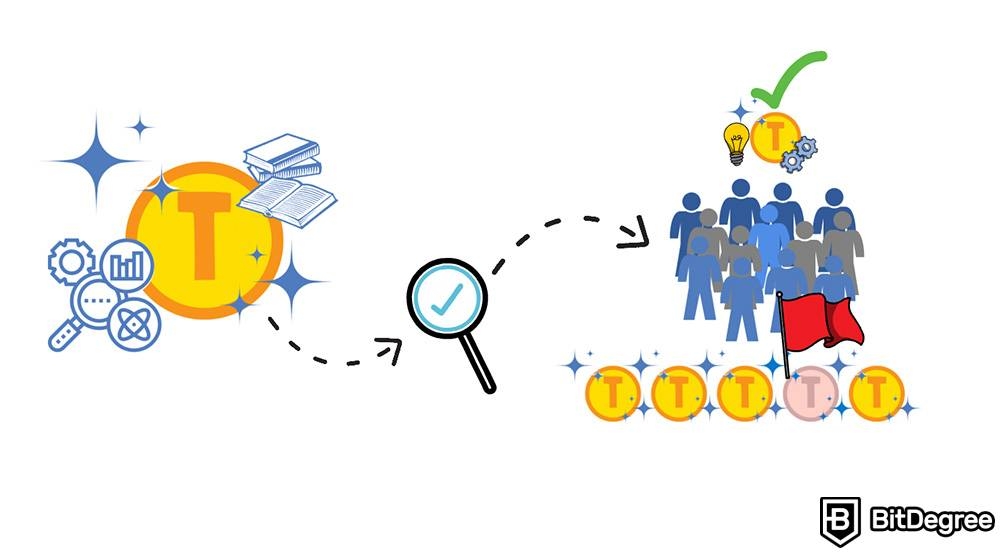
If you feel like you need to refresh your knowledge about these key indicators, be sure to check this section, where I cover and explain these terms in detail!
OK, back to tokenomics research. Analysis of this kind lets users estimate the functionality of a crypto coin, and whether it’s well thought-through. In many cases, it’s easy to spot red flags immediately. Let’s consider a well-known example.
Tokenomics behind the infamous BitConnect scam made it clear that this project was up to no good from its very inception. The project promised high returns to investors, yet they did not disclose how these returns were generated. In addition, the only utility for the token was… Investing in the Bitconnect lending platform.
Quite obviously, such an ordeal sounds dubious, to say the least. And, conducting tokenomics research was enough to avoid falling victim to this scam.
Airdrop Research
Moving on, let’s talk about researching airdrops. Let’s say you stumble upon a promising project, and airdrops are what they’re talking about.
The term itself refers to the distribution of crypto. The crypto that’s issued by the project you’re interested in. Once again, there is an entire section about this topic, be sure to check it out!

So, a project is organizing an airdrop. In order to understand whether it’s a viable move, and not just a cheap PR trick to attract attention, experienced users go and take a look at how this may affect the coin’s tokenomics, and its role in the DeFi ecosystem.
This means analyzing how the airdrop will affect the coin’s supply, demand, and whether it will not cause a massive drop in its value. Imagine if an airdrop quadrupled the coin’s circulating supply. The particular cryptocurrency would experience major inflation in the blink of an eye.
DeFi Research
I’ve mentioned that experienced traders take into account the project’s role in the entire DeFi ecosystem. But how do they measure such a criterion? By conducting DeFi research.
In its very essence, this means asking the big questions. It means evaluating the role of a particular project in the entire DeFi space. Does the project promise a solution to a problem that hasn’t been solved yet? Does the project offer a real use case?

Evaluating crypto projects based on their utility sounds like a no-brainer. Yet, you’d be surprised how many projects have been created just for the sake of attracting investors' money. And they succeeded just because the creators knew how to cover the uselessness of their project in hip, glittery buzzwords.
Let’s take a look at an example. Back in 2014, a new crypto was being introduced to the market. It was called Coinye. And yes, it was named after Kanye West. Quite obviously, this coin had literally zero utility, and was built entirely to capitalize on the pun. West’s legal team brought this project down very quickly, and the only losers were those who actually invested in it.
NFT Research
Many projects attract the public's attention by releasing NFT collections. If you think you’d like to learn more about NFTs, check this section out. But today, we’re here to learn how to research crypto projects, and, in this case, their NFT collections.
So, when you find out about a project and its NFT collection, in order to conduct a proper inspection of it, these are the aspects that require attention.
First of all, take a look at what is the blockchain network that the NFT collection is released on. A well-established, and trustworthy blockchain is the first green flag. It also allows you to evaluate whether the project will potentially face scaling, security, and similar issues.
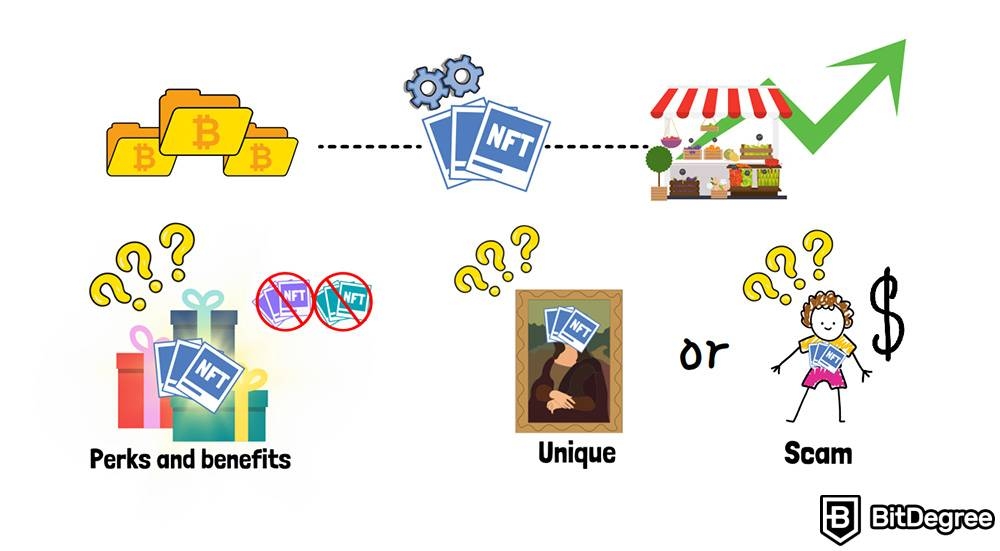
Other aspects include the people behind the project, whether they are industry-insiders, and not some inexperienced strangers. Then, evaluating the strength of the community is important. How many people engage with the project’s communication? How buzzing the atmosphere is? The more people, the more accountability the project developers hold.
Besides that, just like with crypto projects in general, it’s important to evaluate the collection’s market potential. Does it have any perks and benefits that other collections don’t offer? Is it a unique project or just a cheap attempt at cashing out at the expense of the uninformed beginners?
How to Research Crypto?
As you can see, there are many different approaches and angles to researching crypto. But, separately, they present only a partial look at a particular crypto project and how solid it really is.
Therefore, let’s see how to conduct proper research that allows you to evaluate the crypto project as a whole. Because it’s easy to tell people to DYOR - Do Your Own Research, and it’s way more difficult to present a coherent system of how that’s actually done. But, that’s what I’m here for.

So, let’s say a new crypto project pops up in your newsfeed. It looks promising, revolutionary even. The temptation to invest in it is real. But… Is it legit? Time to do some research.
What’s the first step? Going on the project’s website, seeing if it looks reliable, well thought-through and not shady? Wrong. That’s what many users do, and scammers are very much aware of that. Sometimes they create websites that look more legit and trustworthy than those of real, value-creation-oriented companies.
Step 1: Check Out Telegram and Reddit
The first step, instead of going on the company’s website, is to go and check out Telegram and Reddit. These places play the role of crypto research sites, since this is where the under-the-hood talk takes place.
Whether it’s the official project’s Telegram channel, or just people discussing it on a tech-related forum, this is precisely where you could find the first signals that the project is, indeed, legit.
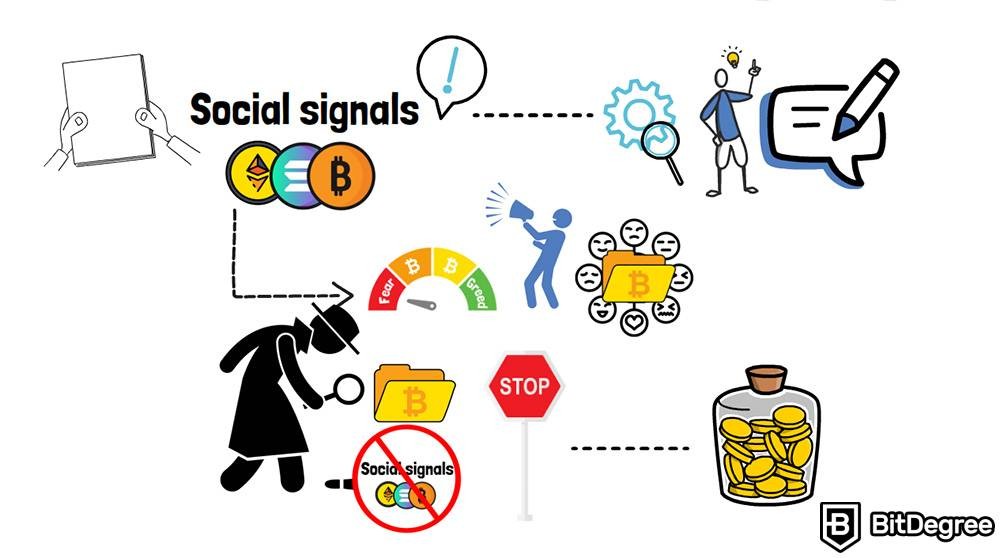
The term “social signals” is something that’s important to keep in mind while researching crypto. It refers to various indicators that let people know whether a project is actually talked about. Social signals represent the prevailing market sentiment, public opinion and feelings surrounding the particular crypto project.
If you can’t find any social signals regarding a crypto project, it’s an indicator that you shouldn’t act in haste when it comes to making a financial decision. But, how does social signal tracking look like?
The good news is that there are platforms, designed specifically for this purpose. One of them is the BitDegree Social Signals & Traffic Tracker. Once you’re on it, you select a crypto project of your choice, and all the most recent social signals-related data is presented to you. You’ll see stuff like stats from Twitter, Reddit, Telegram, trending posts and such data as their website’s traffic.
Keep in mind that many fresh projects may not yet have enough data to be presented by the social signal tracker. But, taking a look at the well-established projects through the tracker can give you an idea of what a healthy and trustworthy crypto project looks like.
Okay, so, what do we do when a project is so young and fresh that the social signal tracker is not enough for us to evaluate its potential? We get ready to embark on the research journey. And the first stop is checking their social media.
Step 2: Check Out Twitter
I’ve already mentioned the importance of checking out Telegram and Reddit, as the primary sources of critically-evaluated information regarding particular crypto projects.

Then, it’s time for Twitter. After all, this is where everything happens. Yet, if you only take Twitter into consideration, you could easily miss out on serious, technical projects. Many of them don’t have a huge following, or overly-active social media presence.
On the flip side, many new low-volume projects overemphasize the importance of their Twitter performance, and their self-promo content may flood your newsfeed. Therefore, it’s important to keep in mind that just because a project knows how to build a Twitter following by posting nice pieces of content, doesn’t necessarily mean that this project is a valid one.
Step 3: Analyze the Whitepaper and Funding
Now, having established that a project is being discussed in various forums, and has a valid Twitter presence, it’s less risky to go to their website.
And that’s where you’ll most likely find two key ingredients that will allow you to continue with your research. The first one is the company’s whitepaper.
A whitepaper is a document that emphasizes the technical side of the project, its features, goals, and potential. These documents are usually written by the core members of the project’s team, and they can reveal a lot about how serious it is. In this context, whitepapers are like some kind of crypto research reports.
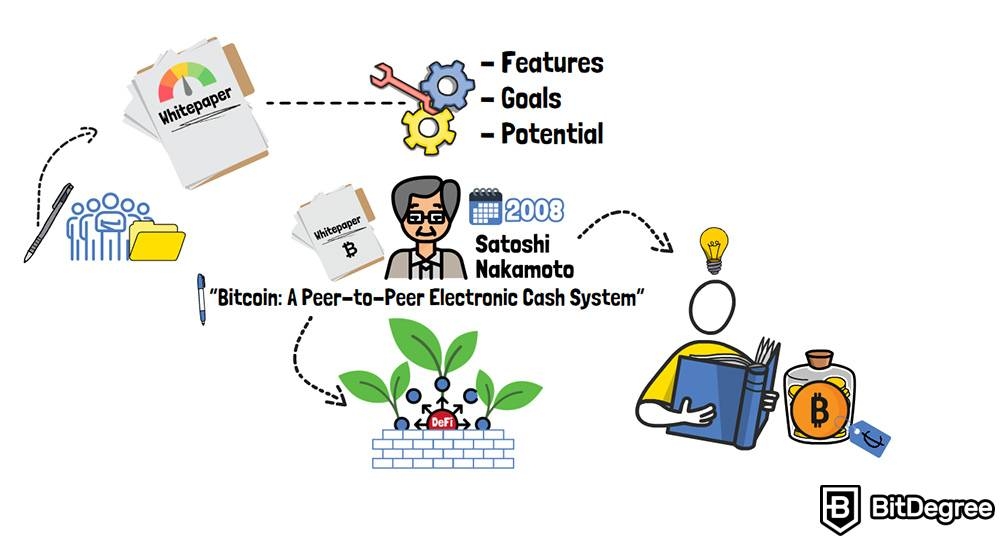
A great example is the famous Bitcoin whitepaper. Written in 2008 by the enigmatic Satoshi Nakamoto, and titled “Bitcoin: A Peer-to-Peer Electronic Cash System”, this document presented an idea which, eventually, became the foundation for the entire DeFi system.
Those who’ve read it, and realized its potential, were the ones who didn’t hesitate to get themselves enough Bitcoin when its price was still in the cents.
Apart from the technical details, whitepapers allow users to accurately evaluate the product’s use case, and how realistic it is to expect a demand for it. This allows users to get the answers to the previously mentioned big questions of “why?” and “how?” is this project being developed? If the answers don’t satisfy you, it’s a clear indicator that the project is probably not worth your attention.
The second ingredient is funding.
Usually, you’ll be able to find this information on the project’s website, in the “funding” section. There, you’ll be able to see what investors and financial backers have already shown their belief in the project. And, of course, if you find prominent names among them, it’s a green flag.
Wrapping Up
This brings us to the end of this section. I hope that, by now, it has become clearer how to research crypto. It’s a vital part of being successful in this field. Therefore, it’s essential that traders, especially beginners, know where to start, and avoid falling victim to scammers & zero-value projects.















